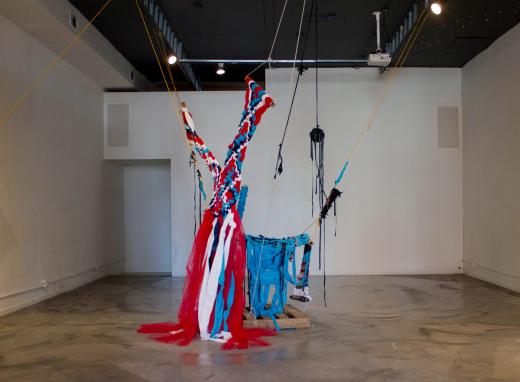Joy of Weaving - What remains
The relics that Joseph Raven has collected from international performance artists as part of the project “Defibrillator” are exhibited in the ARC gallery.
For the project "What remains –on the sacred, the lost and the forgotten" curated by Ieke Trinks, international artists are invited to continue working with these relics. The resulting performances take place over a period of 4 weeks in the ARC gallery and the resulting installations and relics are exhibited here.
I choose the textile relics of the performance EXTENSION by the artists Stephanie Black Daniels and the performance "Dressing the future in my humility" by Joshua McGarvey.
These are many, very long bands made of a black synthetic material (Black-Daniels) and 13 blue children's jogging pants (McGarvey).
I cut the sweatpants into strips. In addition to these materials, I receive fabrics from the festival organizer that he no longer needs. I pull a pallet and various cardboard tubes out of the rubbish. With this and with ropes, which are also relics (from a performance by Tomasz Szrama) from the fund of the gallery, I construct a spatial installation.
I braid long strings from the black ribbons and knot a ball, which I fill with remnants of the blue trousers which I cut in stripes. With the large fabrics I start a monumental weaving. The other materials (relics) are woven in a horizontal installation. During the week I spent in the gallery with the materials, the parts come together into an overall installation, matching the theme of the week: Merge.
In connection with the performance, which takes place in front of an audience, visitors bring other textile materials and weave them into the installation.
After the installation completely "goes down" as part of the performance, it is installed again in the gallerie after the performance.
For the remaining weeks, the central part of the installation remains in the gallery as an exhibit, the rest joins the stored relics.
I surround myself from the beginning with the materials and stories I have chosen. The blue children's jogging pants are self-sewn by the artist and made of an extremely soft material. The artist assoziates the trousers with a feeling of humiliation, which he experienced as a child when he wore sweatpants and drenched himself on a stage play. The soft consistency of the pants and their history make me lovingly and carefully handle them. Cutting up becomes a deliberate ritual.
The straps are more robust and cannot be manipulated. I use them as they are. They served Stephanie Black Daniel to extend her body and are an expression of her femininity. It is coherent for me to handcraft with them, to braid and weave them, to treat them in a similar way to body's own material (like hair), and even to create a new independent body from it (ball).
The installation arises by doing. The selected objects fit together organically, sometimes it requires tension, weight, or the stiffening of a supporting material. I solve all of these requirements with the existing recycled objects. The materials by Joseph Raven combined with stripes of the blue trousers result in a dress-like object that hovers in the room queenlike. The resulting installation expresses opposites like:
The sublime combined with the low, textiles chosen as artpieces combined with materials from the garbage. Carefully knotted texture combines with "sloppy" interwoven remains.
The visitors bring in their various qualifications in terms of weaving and knotting. There is no standard of perfection or aesthetic plan. My person takes on the role of instructor or intermediary, I create the installation just like the visitors without having any idea how it should look like at the end. On the day of the performance, the installation is completed and also deconstructed. (see: Joy of Weaving- What remains-Performance). Remnants of the clothing that I wore during the performance are also now woven into the installation.
This work is therefore a collaborative effort by the artists whose material was used, but also by the visitors and other protagonists (artists of the project, assistant) who participated. That and that I personally and immediately surrounded myself with the materials in terms of color, feel, texture and their history have made me realize that artistic work is about more than planning an aesthetic and meaningful work of art.
For me, it is about letting go and the impact the immediate surroundings and the people around me have, the trust that something arises from the existing and letting go of intellectual concepts. Due to the careful selection and treatment by the actual artists, the materials already contain a great deal of information that, when dealing with them, intervene in the development of the artistic work without an action on purpose.
In this case, the quality of the work is not created by weighing up possible aesthetic results and intellectual concepts, but by allowing the self-generating elements to show up.
For me it was an experience and also a great challenge, because up to now a large part of my work was dedicated to my desire for control, through which I thought I could achieve maximum artistic quality.
Thanks to everyone who made this possible: Ieke Trinks, Joseph Raven, Joshua McGarvey, Stephanie Black Daniels, Sandra Meder, Marcel, Natalia, Emily, Kirsten, Jolanda and many more.
As part of the project:
WHAT REMAINS
On the Sacred, The Lost and The Forgotten
Relics of Live Art;
Curated and organized by Ieke Trinks and Joseph Raven,
Defibrillator at ARC Gallery,
Chicago, USA
Assistant: Sandra Meder
Pics by Ieke Trinks, Natalia Nicholson, Gages Sixkiller Kroll, John Thomure

























